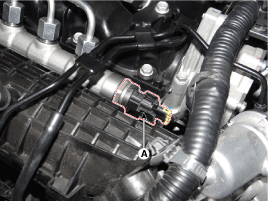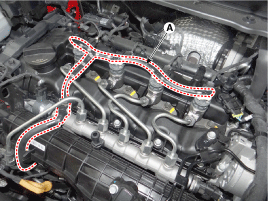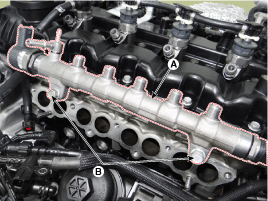Disconnect the rail pressure sensor connector (A).

Common Rail Fuel Injection System operates at extremely high pressure (approximately 2,000 bar), so do not perform any work on injection system with engine running or within 30 seconds after the engine stops.
Keep the components of common rail system and the working are clean.
Avoid influx of foreign substances when installing the fuel supply system.
Remove the protecting cap from injector, tube or hose just before installing it to prevent the influx of foreign substances.
Do not remove injector except in special case.
When installing the injector
- Clean the contacting area of the injector and replace the gasket with a new one.
- Vertically insert the injector into the cylinder head to prevent the damage caused by shock.
- Clean the surface under the injector gasket of the cylinder head before installing the injector.
When installing High Pressure Fuel Pipe
- Install the flange nut correctly.
- Do not reuse high pressure fuel pipe. Always use a new one.
When removing / installing the injector return line
- Insert the connector only in unlocked status.
- Insert the connector by hand. Do not use a tool
Turn ignition switch OFF and disconnect the battery negative (-) battery terminal.
Disconnect the rail pressure sensor connector (A).

Disconnect the fuel return line (A) from the injector.

Disconnect the high pressure fuel pipe flange nut (B) after loosening the clamp mounting bolt (A).
High pressure fuel pipe clamp mounting bolt:
6.8 ~ 10.7 N.m (0.7 ~ 1.1 kgf.m, 5.1 ~ 8.0 lb-ft)
High pressure fuel pipe flange nut:
24.5 ~ 28.4 N.m (2.5 ~ 2.9 kgf.m, 18.1 ~ 21.0 lb-ft)
Remove the high pressure fuel pipe.
Remove the Intake Manifold.
(Refer to Engine Mechanical System -"Intake Manifold")
Remove the common rail (A) after loosening the mounting bolts (B).
Common rail mounting bolt:
14.7 ~ 21.6 N.m (1.5 ~ 2.2 kgf.m, 10.9 ~ 15.9 lb-ft)

Install in the reverse order of removal.
When installing the high pressure fuel pipe, tighten to the specified tightening torques by using the special service tool (SST No.:09314-27120).
After removing or replacing the following parts, bleed air in low pressure fuel circuit.
(Refer to "Air bleeding in low pressure fuel circuit" in this group.)
Fuel tank
Fuel sender
Fuel filter
High pressure fuel pump
Low pressure fuel lines
After removing or replacing fuel system below, the fuel leakage test procedure must be performed. (Refer to "Fuel leak test" in this group.)
Fuel tank
Fuel sender
Fuel filter
High pressure fuel pump
Injector
Common rail
Low pressure fuel line